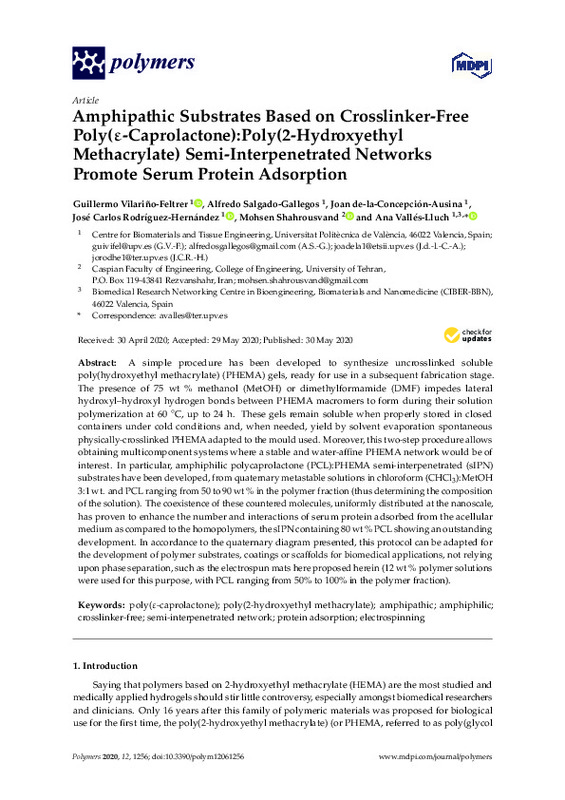JavaScript is disabled for your browser. Some features of this site may not work without it.
Buscar en RiuNet
Listar
Mi cuenta
Estadísticas
Ayuda RiuNet
Admin. UPV
Amphipathic Substrates Based on Crosslinker-Free Poly(epsilon-Caprolactone):Poly(2-Hydroxyethyl Methacrylate) Semi-Interpenetrated Networks Promote Serum Protein Adsorption
Mostrar el registro sencillo del ítem
Ficheros en el ítem
| dc.contributor.author | Vilariño, Guillermo
|
es_ES |
| dc.contributor.author | Salgado-Gallegos, Alfredo
|
es_ES |
| dc.contributor.author | De-la-Concepción-Ausina, Joan
|
es_ES |
| dc.contributor.author | Rodriguez-Hernandez, Jose-Carlos
|
es_ES |
| dc.contributor.author | Shahrousvand, Mohsen
|
es_ES |
| dc.contributor.author | Vallés Lluch, Ana
|
es_ES |
| dc.date.accessioned | 2021-11-05T14:13:01Z | |
| dc.date.available | 2021-11-05T14:13:01Z | |
| dc.date.issued | 2020-06 | es_ES |
| dc.identifier.uri | http://hdl.handle.net/10251/176529 | |
| dc.description.abstract | [EN] A simple procedure has been developed to synthesize uncrosslinked soluble poly(hydroxyethyl methacrylate) (PHEMA) gels, ready for use in a subsequent fabrication stage. The presence of 75 wt % methanol (MetOH) or dimethylformamide (DMF) impedes lateral hydroxyl-hydroxyl hydrogen bonds between PHEMA macromers to form during their solution polymerization at 60 degrees C, up to 24 h. These gels remain soluble when properly stored in closed containers under cold conditions and, when needed, yield by solvent evaporation spontaneous physically-crosslinked PHEMA adapted to the mould used. Moreover, this two-step procedure allows obtaining multicomponent systems where a stable and water-affine PHEMA network would be of interest. In particular, amphiphilic polycaprolactone (PCL):PHEMA semi-interpenetrated (sIPN) substrates have been developed, from quaternary metastable solutions in chloroform (CHCl3):MetOH 3:1 wt. and PCL ranging from 50 to 90 wt % in the polymer fraction (thus determining the composition of the solution). The coexistence of these countered molecules, uniformly distributed at the nanoscale, has proven to enhance the number and interactions of serum protein adsorbed from the acellular medium as compared to the homopolymers, the sIPN containing 80 wt % PCL showing an outstanding development. In accordance to the quaternary diagram presented, this protocol can be adapted for the development of polymer substrates, coatings or scaffolds for biomedical applications, not relying upon phase separation, such as the electrospun mats here proposed herein (12 wt % polymer solutions were used for this purpose, with PCL ranging from 50% to 100% in the polymer fraction). | es_ES |
| dc.description.sponsorship | This research was funded by the Spanish Ministerio de Economia y Competitividad, grant number DPI2015-65401-C3-2-R. | es_ES |
| dc.language | Inglés | es_ES |
| dc.publisher | MDPI AG | es_ES |
| dc.relation.ispartof | Polymers | es_ES |
| dc.rights | Reconocimiento (by) | es_ES |
| dc.subject | Poly(epsilon-caprolactone) | es_ES |
| dc.subject | Poly(2-hydroxyethyl methacrylate) | es_ES |
| dc.subject | Amphipathic | es_ES |
| dc.subject | Amphiphilic | es_ES |
| dc.subject | Crosslinker-free | es_ES |
| dc.subject | Semi-interpenetrated network | es_ES |
| dc.subject | Protein adsorption | es_ES |
| dc.subject | Electrospinning | es_ES |
| dc.subject.classification | MAQUINAS Y MOTORES TERMICOS | es_ES |
| dc.title | Amphipathic Substrates Based on Crosslinker-Free Poly(epsilon-Caprolactone):Poly(2-Hydroxyethyl Methacrylate) Semi-Interpenetrated Networks Promote Serum Protein Adsorption | es_ES |
| dc.type | Artículo | es_ES |
| dc.identifier.doi | 10.3390/polym12061256 | es_ES |
| dc.relation.projectID | info:eu-repo/grantAgreement/MINECO//DPI2015-65401-C3-2-R//SOPORTES POLIMERICOS MULTIFUNCIONALES PARA CO-CULTIVO CELULAR INDIRECTO Y ESTIMULACION QUIMICA DESTINADOS A MIMETIZAR TEJIDO RENAL IN VITRO/ | es_ES |
| dc.rights.accessRights | Abierto | es_ES |
| dc.contributor.affiliation | Universitat Politècnica de València. Departamento de Termodinámica Aplicada - Departament de Termodinàmica Aplicada | es_ES |
| dc.description.bibliographicCitation | Vilariño, G.; Salgado-Gallegos, A.; De-La-Concepción-Ausina, J.; Rodriguez-Hernandez, J.; Shahrousvand, M.; Vallés Lluch, A. (2020). Amphipathic Substrates Based on Crosslinker-Free Poly(epsilon-Caprolactone):Poly(2-Hydroxyethyl Methacrylate) Semi-Interpenetrated Networks Promote Serum Protein Adsorption. Polymers. 12(6):1-14. https://doi.org/10.3390/polym12061256 | es_ES |
| dc.description.accrualMethod | S | es_ES |
| dc.relation.publisherversion | https://doi.org/10.3390/polym12061256 | es_ES |
| dc.description.upvformatpinicio | 1 | es_ES |
| dc.description.upvformatpfin | 14 | es_ES |
| dc.type.version | info:eu-repo/semantics/publishedVersion | es_ES |
| dc.description.volume | 12 | es_ES |
| dc.description.issue | 6 | es_ES |
| dc.identifier.eissn | 2073-4360 | es_ES |
| dc.identifier.pmid | 32486185 | es_ES |
| dc.identifier.pmcid | PMC7361809 | es_ES |
| dc.relation.pasarela | S\417321 | es_ES |
| dc.contributor.funder | Ministerio de Economía y Competitividad | es_ES |








